Perhaps I should start with the blue of the sea because it is a blue I’ve never seen in nature before. Deep and inky, the most iridescent blue I’ve ever seen, and it went on for miles and miles. I could sit for hours on deck — and at times I did — with my journal open, a glass of rosé, doing nothing, just gazing into the sea. If the whole cruise had consisted of just that, it would have sufficed. But there was much ahead.
Before we set sail, I recalled the words of my favorite Cavafy poem, “Ithaka.” “As you sail out for Ithaka / Hope the voyage is a long one. Full of adventure, full of discovery.” I had only been to Greece once before as a student. Then, while sitting on the island of Crete and reading Homer, it occurred to me that a circuitous narrative such as “The Odyssey” could only have risen out of this string of islands that we have come to call Greece — just as it seemed to me as if those sprawling Tolstoyian novels could only have to come from a land of great expanse. Each island becomes an episode, each with its own story to tell. And now as we set out on our Wind Spirit voyage, we were about to be making some discoveries of our own.
Athens is so much more than simply our port of embarkation
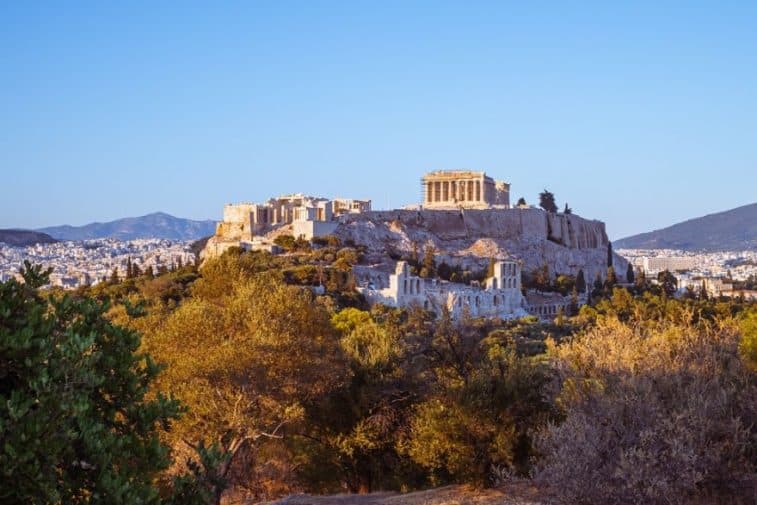
My husband Larry and I arrived in Athens two days before our cruise was to depart, wanting to spend a few days to adjust to the time change and also perhaps the heat. When I told a friend we were going to Greece in June, she made a little face. “It will be hot,” was all she said. And she was right. Still we loved Athens. For our first two nights we had a little rooftop Airbnb with a perfect view of the Acropolis from our shaded patio and, honestly, given the heat, we were very happy to view the magnificent structure from afar.
Indeed all of Athens is essentially built around a view of the Acropolis. Even when we moved to the St. George Lycabettus Lifestyle Hotel, where we’d connect with Windstar and the ship, our vistas, especially on its wonderful Grand Balcony, were always of the Acropolis. Ever since it was first inhabited 5,000 years ago, this flat outcropping has provided Athens with its vantage point on the world and also its protection. Never mind that the general and statesman Pericles managed to bankrupt the coffers of Athens to rebuild it after it was destroyed in 479 B.C. by the Persians. The beauty and elegance that Pericles envisioned have endured to this day.
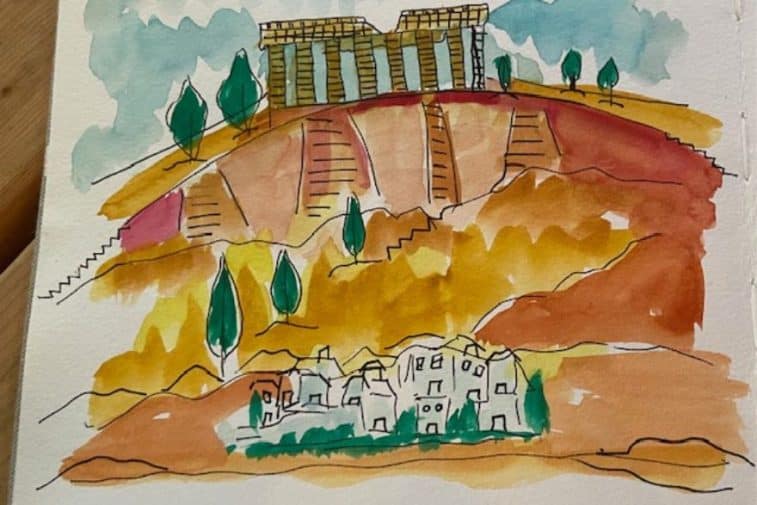
We had compiled a list of outstanding restaurants in Athens and we did try one. But in the end, I found that wandering the streets and finding those lively, local spots where people were laughing and the wine was flowing and platters of seafood kept arriving seemed more to our taste. It was here in Athens at a lovely place named Strofi that I discovered the wonders of the perfect moussaka. Trust me. There is no turning back.
In part because of the heat, we actually spent our first full day at the Acropolis museum, which has two advantages beyond its archaeological history. You have a glorious view of — guess what — the Acropolis, but it is also perfectly air-conditioned. However, the aspect of the museum that most moved me was the so-called “Elgin” marbles. The 50 panels of the Parthenon Frieze, which includes animated carvings of maidens, priests, horses, soldiers and so on are actually located at the British Museum in London, which is where Lord Elgin had them shipped when he took them from the Parthenon in 1801. Greece, of course, has been demanding their return, an effort that gained traction in the 1980s when the late actress Melina Mercouri served as Greece’s cultural minister. The issue is at a standoff but the Greeks have created a moving exhibit, using plaster of Paris reproductions of the missing panels. The museum in Athens is making a clear statement about where those marbles belong.
So in the end, we saw the Acropolis many times, but always from a vantage point, a distance. We were all right with that. I actually loved looking at Athens from on high and the St. George was the perfect perch. But I didn’t fully appreciate the view until we sat and looked at how close we were to the sea and even to one of the Greek isles. I think it is safe to say that everything about Athens is designed to enable you to see the Acropolis from perches around the city.
Wind Spirit is our home away from home
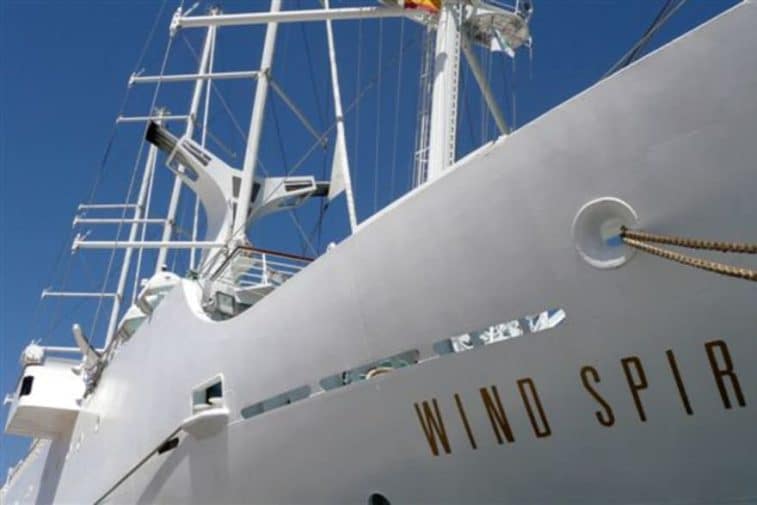
On Sunday we grabbed a taxi for Piraeus with Costas, a cab driver whose face recalled a finely honed Greek sculpture and who began speaking to us rather spontaneously about why he loves Athens. “Because it’s an ugly city,” Costas said. “Because it makes no sense. It has little appeal. It isn’t Paris or Rome. But you know what I love about Athens? It has character.” The way he spoke about Greece made me recall the wild Greek poet, Katsimbalis, in Henry Miller’s travelogue, “The Colossus of Maroussi.”
“You should be a writer, Costas,” I told him, looking at his dancing blue eyes in the rearview mirror.
“I’m a cab driver,” he replied humbly.
Our ship, the Wind Spirit, was waiting for us. There in the embarkation area we were greeted by a lovely, blue-eyed Greek woman, aptly named Odyssia, whose job it was to shepherd us through the various checkpoints and metal detectors, making sure our papers were in order, and then bid us a good journey as we approached the desk where we would relinquish our passports and be given our ship ID card.
And soon we were being guided to Wind Spirit where she stood waiting, docked, just back from a previous voyage but shipshape and awaiting her new and eager voyagers. It’s not a big ship. It only has about 130 cabins. But it’s a sleek, tight sailing vessel with six sails that would soon be unfurled.
We found our cabin quickly and it was what I’d anticipated: also small and compact with two portholes and a very comfortable queen-size bed. We quickly settled in and then made our way on to the deck for a quick meet and greet and glass of Champagne just before sailing. My favorite line overheard at the meet and greet was from a woman who asked our very excellent Malaysian bartender where the Champagne was from. He looked at her oddly and replied, “Champagne.”
And suddenly the captain’s voice came booming over the loudspeaker. He informed us in his deep, resonating voice that the time had come to hoist our sails and set forth on our journey. All eyes were on the sails as the stirring strains of Vangelis’ soundtrack of 1492 from the film “Conquest of Paradise” came over the loudspeakers and we watched the sails rise with the music playing, all guests standing still as if at attention as we set off to our next port of call.
Discovering offbeat Mykonos

Honestly, I thought I’d hate Mykonos. In fact, I was fully prepared to. I knew about its jet-setting history, how it got discovered by people like Jackie Onassis and well-known fashion designers. We knew that there were hotel rooms that went for $5,000 a night and that you could helicopter into these resorts. I just assumed it would be very “White Lotus.” But actually we found it pretty chill, surprisingly so. On arriving, we sat down at a café, ordered some cold drinks and just watched the world go by. Boats came in and out; fishermen were selling their catches of the day. A small farmers market was open in front of us and women with their shopping bags squeezed tomatoes, sniffed melons.
We walked around town where I found a wonderful dress shop, named Bellou, run by a mother and her daughter, that was packed full of linen. Larry had to drag me away. I promised I’d be back, but we’d been hoping for a beach visit. In the guidebook, I read that if you want a chill lunch and a nice swim, you should go to Kiki’s, about 5 miles outside of town. That felt right to me, but we had to find a taxi which proved fairly challenging. We walked for a way until finally we had reached the edge of town.
Suddenly, a very handsome man who looked a bit like Poseidon, wearing swim shorts and a T-shirt and very tan and fit, approached us. “Are you looking for a cab?” In fact, we told him, we were. It turned out that this gentleman actually owned all the cabs on the island. He could easily retire but he loved to work. He went to his office every day and basically dispatched his cabs. The driver he sent us with took us along winding roads through a bucolic landscape of rolling hills and wide fields until we came to a sandy road that descended towards the beach. “I can’t go any farther …” he said. Our young driver let us off and promised to return in three hours. He understood that we had to make the last tender.
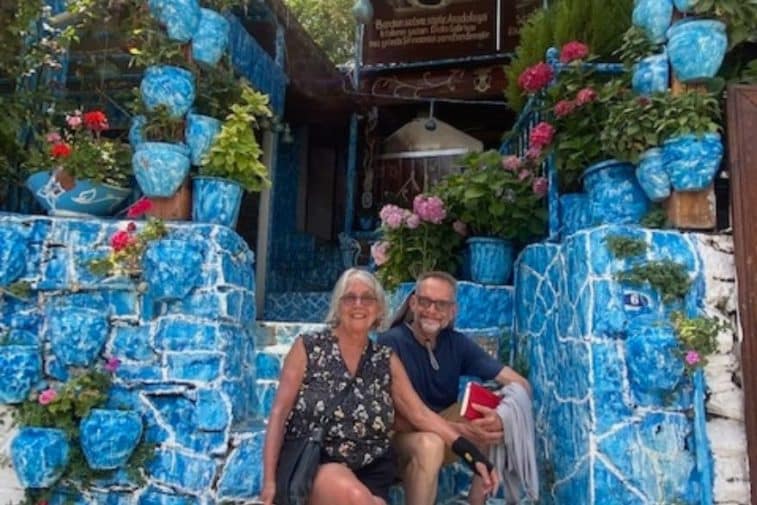
As we walked down toward the beach, we didn’t see a restaurant. That’s because Kiki’s is basically a shack. You can walk by it (we actually did). But once you see it, you’ll know. It’s an outdoor patio, covered with an arbor about 100 yards above the sea. Maybe it had some inside tables but I didn’t notice. Anyway, we got there almost as it opened, and the gentleman in charge, a large, burly Zorba the Greek-looking man who smoked nonstop, grunted out answers to questions which usually entailed how long the wait is. We gave him our names and he told us to wait. “An hour,” he said.
I stared longingly at the sea. “Can we put our name in and go for a swim?”
“You go,” he said to me tersely. “He stays.”
Actually this wasn’t a problem because I love to swim in the sea and Larry likes to sit and stare into space and watch the world go by. So while we waited for our table, I jumped into the cleanest, bluest water I think I’d ever seen. And I could go on and on about the blue of Aegean because it’s not like any other blue. I’d honestly say it’s not a blue found in nature except, of course, this is nature. It’s hard to describe the sweetness of the water, the air, the gentle lapping of the waves. I suppose it’s hard to describe heaven.
I swam happily around until I thought I heard someone shouting and looked up and saw Larry on the patio of Kiki’s signaling me that our table was ready. Lunch was easy: a delicious plate of mezze and grilled squid, some Greek white wine and that was it. We sat in this little packed patio under the arbor and put the world on pause. After lunch, I went back down to the sea and Larry joined me. Even he, a nonswimmer, had to admit that the water was something special.
Then at 3:45 p.m., it was time to meet our taxi and he was there on the dot. Now sated and soaked, we headed reluctantly back into town where everything felt very chaotic after our peaceful visit to the beach. Suddenly there was traffic, horns honking, people bustling. As we headed back along the waterfront, I had time to duck one more time into Bellou where I admired the blue shirt the owner was wearing. She raised up the front and, without any hesitation, said, “Look, you just slip it on.” And displayed for me her bare breasts.
I bought the shirt and a dress as we happily headed back to Wind Spirit.
Magical, mystical Ephesus
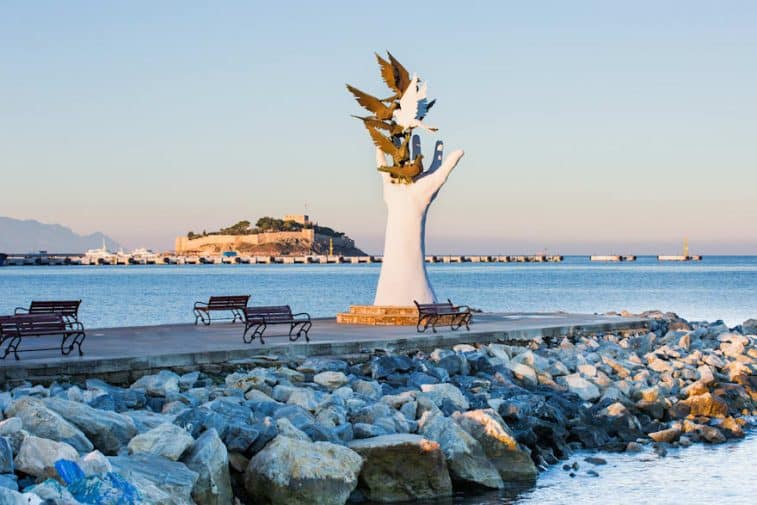
In Ephesus, we decided to go a bit rogue. We hired a private guide via a friend who knew people in the area. We wanted something a little offbeat and we also wanted to go to lunch at a local place — all of which Gul delivered on. We met her at the ferry landing at Starbucks, though it felt strange to travel halfway around the world and end up at Starbucks. Gul was a lovely young woman, and she knew the area well. She also didn’t talk “at” us, which we appreciated.
Gul’s company was just right to give us the guidance we needed in taking the time to explore the site. Rather than start at the parking lot main entrance, we began from the entryway near a glassed scaled replica of what Ephesus looked like in its heyday. Here we had context for what was to come, as we walked in the light shade of our umbrellas down the narrow passageway of the Heracles Gate to the grand Celsius Library of Ephesus.
There is nothing that can quite prepare you for your first sight of the ruins of Ephesus. Here is a land that has changed little since the early 1950s when Freya Stark wrote about it, in “Ionia: A Quest.” It is a place where globalization set down ancient roots. In Stark’s account, she describes ancient Ephesus where all the races of Asia and the Aegean met and mingled; here, she wrote, “it is impossible to touch the coast of Asia Minor without hitting 5,000 years of history.”
It would have been a perfect day except for once more the heat. After a couple hours at the ruins, which are truly remarkable, we went to the charming town of Sirince and ate at a blue tavern. And after a delicious lunch of, guess what, mezze and salad, we headed back to the ship.
What is a Destination Discovery Event at Windstar? It’s part of what makes Ephesus so special
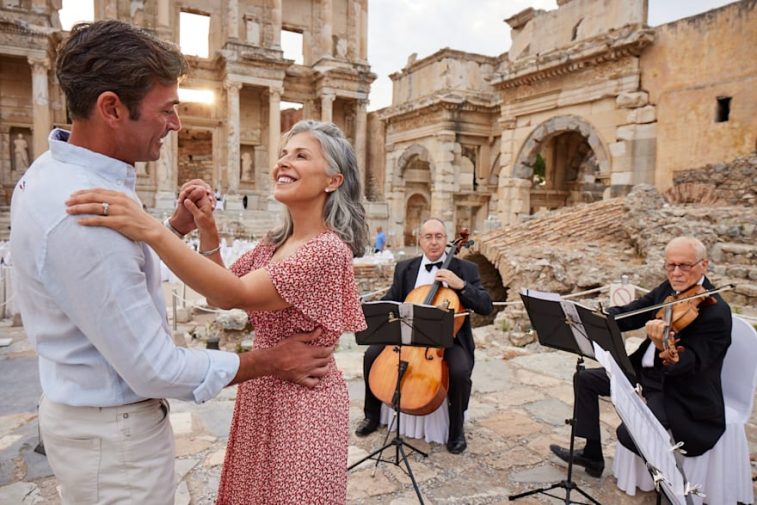
Ever since we booked this trip, I was drawn to the Destination Discovery Event, to which all guests were invited for a moonlight dinner and concert under the stars in the courtyard of the former Celsus Library in ancient Ephesus. The library housed 12,000 scrolls over 2,000 years ago. It was to be the highlight of the trip (and trust me, there were many highlights), and didn’t disappoint.
That evening after a rest and quick showers, we headed to the buses waiting to take us to dinner at the ruins. The buses dropped us off where we’d been earlier that day, but now it was evening and the air was cool. We strolled along the tree-lined path taking us to the ancient library of Ephesus, where we’d have dinner under the stars. We arrived to find elegant tables set up for dinner and a string quartet playing from the stone steps. As Windstar guests, we had the courtyard of the library all to ourselves, enjoying a delicious meal of eggplant in lemon sauce, leafy green purslane with yogurt, a savory veal stew and a steady flow of wine. There were no crowds. No rush. Just music and dinner under the stars in this magnificent sight — a night I will never forget.
Afterward, we strolled back to the buses along the lit paths as local families wandered among the timeless stones.
Swimming in the sea, redux
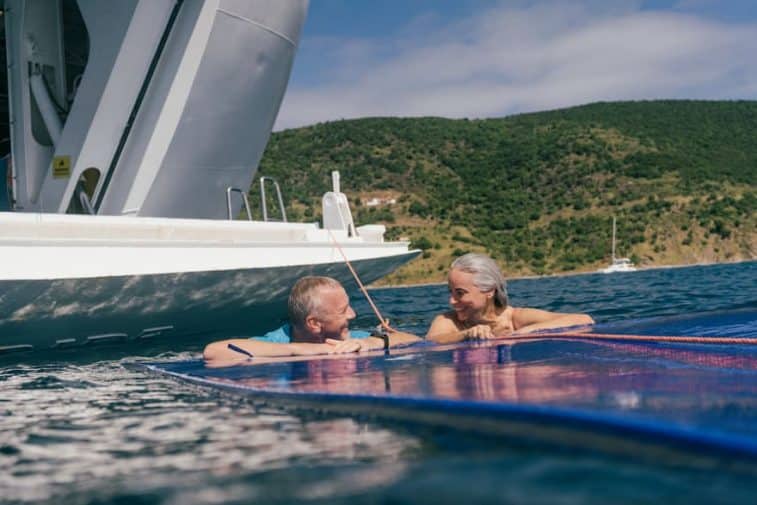
Can we talk for a moment about the swim platform that you’ll find on all of Windstar’s ships, including of course Wind Spirit? Out of the many things to do on this cruise, I loved the swim platform the most. First I love water. I love being in water, on water. And I look for swimming opportunities wherever I go. The swim platform, which was essentially the back of the ship that opened up, was at the end of our corridor. It was only open when the seas permitted it. Some days it was too rough. But after our day on Patmos, it was open, and I slipped into my bathing suit and headed there.
The water looked like a playground for seals. It was filled with rafts, strung together, and ropes to hang on to (you definitely want to hang on to the rope) and various toys like paddle boards. After turning in my keycard to the lifeguards (so they can be sure no stragglers are left in the water when we sail), I jumped in the water. The sea was so smooth, so deceptively gentle. I happily swam out until I realized that I had gone a bit far. Or perhaps the lifeguard blew his whistle to tell me to turn around. At any rate, I found I couldn’t get back. The current was too strong. A former marine and two of his buddies, sensing my distress, caught up with me and helped me get back to one of the ropes. Trust me, I held on.
And then I just happily floated along with everyone else. A perfect way to end a day.
After that we’d managed to snag a table at Candles, Wind Spirit’s seafood and steakhouse, where we ate on deck, sipping wine, watching the sun set, and eating a delicious filet mignon, cooked to perfection, and did what I’ve learned to do best on this voyage: gaze at the sea.
In Santorini we celebrate a volcano’s caldera
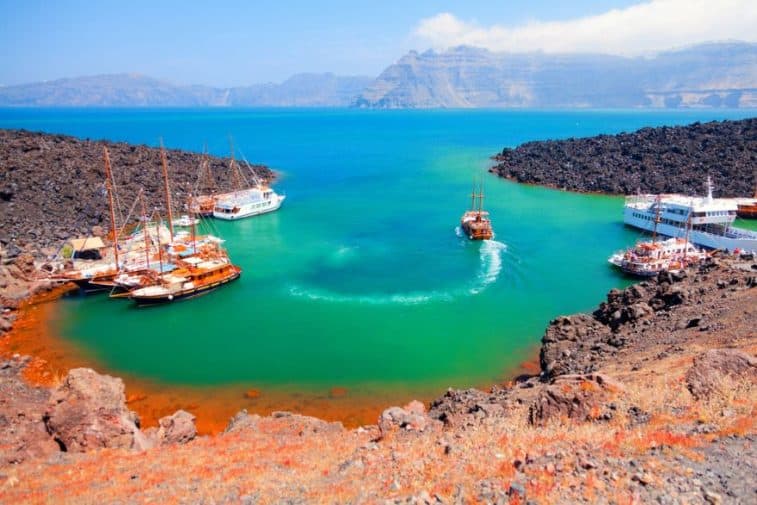
The view of Santorini from the sea will take your breath away. It was a place I’d always wanted to visit, and we gasped to see from our cabin porthole the blue domes and white buildings perched on the cliffs 1,000 feet above us, against that azure sky. If only I could get that blue in my watercolor painting, I thought! We were told by the captain that there’d be other cruise ships visiting Santorini, as many as five, he said. But we didn’t notice them as our ship dropped anchor.
As Wind Spirit sailed into the caldera and docked below the town of Fira, I stood mesmerized on the deck. I gazed up 1,000 feet in awe at the switchback path and 200-plus steps that the locals had walked up and down for hundreds of years. (We would opt for the cable car.) But as our guide on “Sailing the Caldera,” our excursion here, explained, the locals like to walk. Yet they do walk very slowly.
For four hours, we sailed around the caldera — which is basically the crater of a dormant volcano filled with water — on a small catamaran with a dozen other people cruising gently. We had swim stops along the way and a delicious lunch prepared on board. It was a gentle, lovely time.
When we returned to the dock, it was only noon and we still had time to kill. The cruise ships were there, but we didn’t pay them much mind. We looked up at the cliffs and at the town of Fira perched up there. We could have returned to the ship. But we’ve always joked about a crazy guy in Alaska who made wild outdoor sculptures and said to us when we stopped to admire his madness, “You’ve come this far and now you’re leaving?”
So we’d come that far and how could we not go up on the cable car to see the fabled town at the top. Alas, on this day the main street of Fira resembled Times Square on New Year’s Eve — wall-to-wall people (I saw a news report this week that the town of Santorini has requested a cap be put on the number of tourists who can visit per day. I hope it succeeds.) So every traveler makes a mistake and while I’m pretty good at travel, we made ours. We decided to leave and tried to find the easier, faster route. The line for the cable car was hundreds of people long in the blazing sun. We could have rented donkeys but that was too touristy for me. I asked a local how long it took to walk the hundreds of steps on the winding path that the locals have used for centuries. Fifteen, 20 minutes, we were told.
We set out in the blazing sun. The steps leading up and down Santorini are ancient slippery stones with quite a bit of donkey dung and no railing. Twenty minutes into our climb down, I had not progressed very far. But it was too late to turn back. I was starting to feel ill as if I couldn’t go on.
“Take off your hat,” Larry told me. And then he poured water into it. “Put it on your head.” Drenched and dizzy, we continued our descent, 250 steps. How hard could that be? Well, it turns out, very hard. And I’m pretty sure no locals were making the descent in the afternoon sun. Ninety minutes later, we were down. Long story short: Next time take the cable car or the donkey — or stick with ship’s shore excursions, in which you tender to a different part of the island. Avoid the heat of the day as the Greeks do.
When we reached the base of the stairs, I collapsed into a chair in a convenience store where Larry bought more water. As I sat, a little wire-haired mutt plunked himself down in the blazing sun. He was obviously the owner’s beloved pet. The crowds were thick coming down the final steps. Tourists passing paused to look at him, and like me probably wondered how he stood the heat, wondering if he was all right.
Clearly like Santorini’s locals, he knew what he was doing.
Our 1st visit to Greece’s Peloponnese, Nafplio was a delightful discovery

Nafplio, our final stop, was a pleasant surprise. First of all, the shopping was great — beautiful little stores that sold honeypots and worry beads and more linens. I mean in Greece, you definitely want to wear linen. We opted for a simple day — a walk through the farmers market, where we admired the neatly stacked fig leaves, all with a lemon resting on top of them. We bought peaches, grapes. We stopped in a shop that only sold worry beads and the saleswoman had much to say about them: how they were made, how they relieved stress. We didn’t hesitate. We bought for ourselves and those at home who I know tend to worry. En route to lunch, we picked up a little honeypot before treating ourselves to a delicious seafood lunch by the sea.
That evening we sailed from Nafplio, relaxed, sated, honey pot in hand, for our final port of call, en route to Piraeus, Athens and ultimately home. Our “Odyssey” was coming to an end. The captain once more came over the loudspeaker and informed us that he was hoisting the sails. But this time instead of hearing the strains from Vangelis, we heard the voice of Andrea Bocelli singing “Con Te Partiro.” Time to say goodbye. It was a stirring close to a beautiful voyage, one that I will carry with me for a very long time.
To come full circle as all odysseys do, back to Cavafy, he concludes his evocative poem with these lines, “Ithaka gave you the marvelous journeys / Without her you would not have set out.”
I am grateful for the marvelous journey. I am so glad we set out.
Editor’s Note: Mary Morris, an award-winning novelist and memorist and her husband Larry O’Connor, a writer and book editor, traveled aboard Windstar Cruises’ Wind Spirit to the Greek Isles. While traveling, they were inspired to write a series of pieces about the experience – both onboard and ashore. If you enjoyed this post, check out their other pieces: Discovering Greece’s Peloponnese via Nafplio and Monemvasia; Choose Your Adventure: In Santorini the Wonderful Experience of the Caldera; and In Greece, Putting Food First. And we have even more stories on a cruise around Greece.














































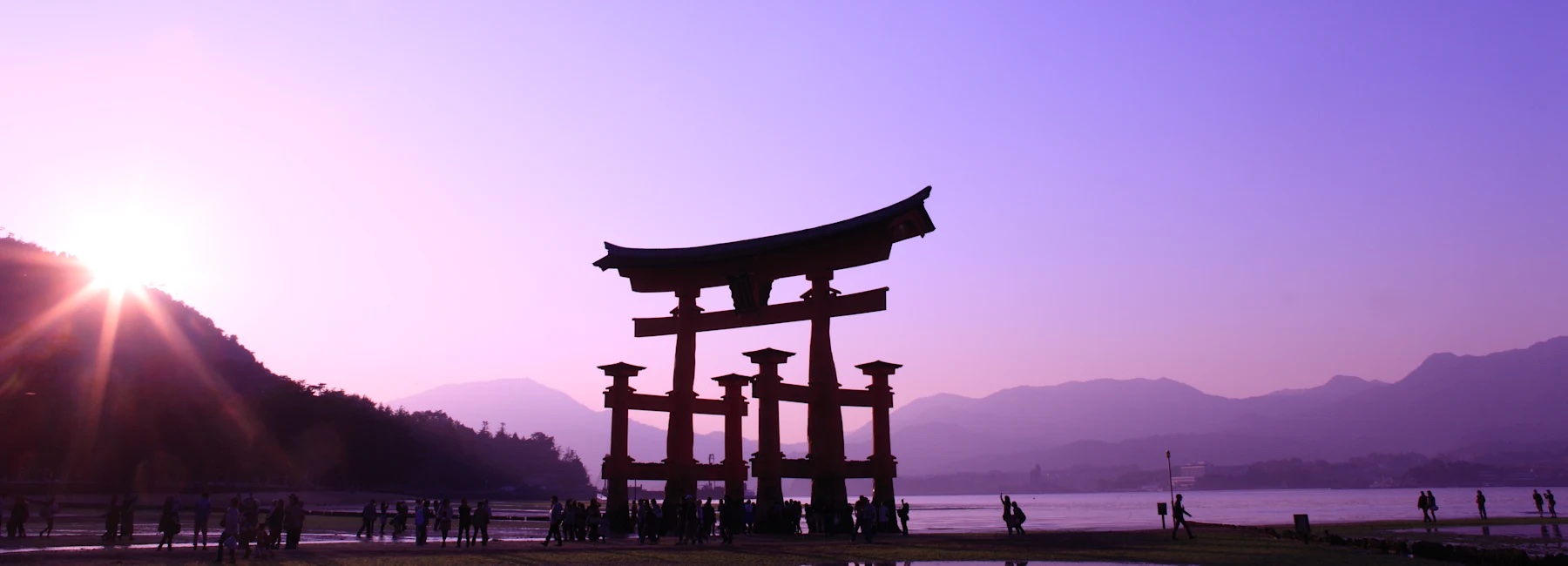




We were on Windsurf last August ‘24. We’ would like to explore Adriatic ports of call and Greek islands on similar ship this year
Thank you ! What a wonderful read … can’t wait for my journey in 2 weeks on the Windspirit
Thanks, Edward, for weighing in. We know you’ll have a wonderful voyage on Wind Spirit! –Carolyn
We sailed on the Wind Spirit in late September 2025. Wow, what an awesome adventure — made so much more enjoyable by the awesome crew & Officers! We loved Mykonos, Milos and Ephesus (especially the excellent dinner), and while Santorini was beautiful, the crowds were crazy… Luckily, our tour guide rearranged the day so we got in/out of Oia before the crowds ruined the ambiance. Arden — the ship’s entertainment director — was AWESOME!!! His singer, Joan, also had a beautiful voice. He is a man of many voices (country, rock, Louie Armstrong) and is a terrific guitar player. We… Read more »
It’s so wonderful to hear about your cruise, “Old No7”! Glad you enjoyed Ephesus, Mykonos and Milos — and, like our writer who wrote the blog on her cruise to Greece, Santorini has awesome options outside of town. Thanks for letting us know about your trip. –Carolyn